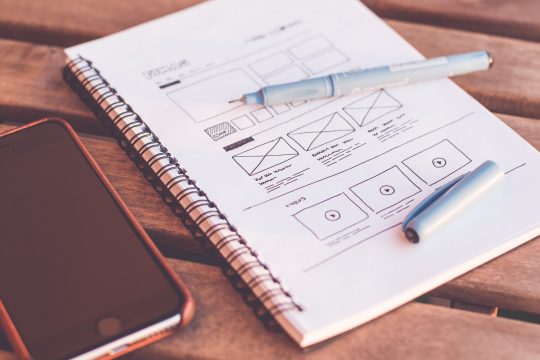
So, you’ve got a great idea for a digital product, but you’re not sure what comes next. What does a digital product actually do? What is it made from? How do you make money out of your idea? What methods of monetisation are out there? Easy, Tiger.
Here at Full Revolution we want to make tech easy to understand for non-technical founders. That means no jargon, buzzwords or acronyms.
(I mean, what is a JamStack ? Sounds like something you might eat for breakfast, right?) Let’s ease you in gently by breaking down what a digital product actually is.
What is a digital product?
A digital product is an intangible item that exists as computer data, which has been built to generate revenue or add value for its creators. They can include phone apps, games, online videos and digital music, basically anything that exists on your computer or digital device.
They can also interact with us out here in the real world, with goods and services. For example, the Uber app facilitates your transport from A to B, and Just Eat provides you with an effortless way to order food from your favourite takeaway.
Features
Digital products are made up of features. Take as an example a website that shows you available rental properties in your area. The website as a whole is the product. It contains ways to search for a property by location, price, type of property and then provide profile pics of these properties so that you can look at them. These are the features, without which the site wouldn’t work. These core features make up the Minimum Viable Product or MVP and add value to the product. (It’s important to remember, if a website then produced a mobile app, that is considered a different product as the tech required is developed separately.)
How are digital products monetised?
So now you know what a digital product is and how it is made up of features. You probably already know which features are going to be core in your product. So how will your customers pay for your product? Different digital products use different methods of payment, some are even free. Let’s break it down again.
Fixed price
This is the most traditional method of purchasing. In the physical world, a product (such as a carton of Um Bongo) that you buy off the shelf, has a price ticket. You willingly hand over your money in exchange for being able to take it home and enjoy. For a digital product, it’s pretty much the same deal. You pay for the product, download it once, and there are no additional costs. This method works well for games, music downloads, and e-books. For the content creator (that’s you) this method is a nice straightforward way of selling your product, minus a commission from the marketplace provider. For customers, you need to be careful regarding your digital purchase. Unless you have a secure copy, you may find it disappears from the online provider after a time. (Such as a game from a streaming platform, or films from iTunes.)
Subscription based and Software as a Service (SaaS)
These are services where you pay for access to use services or software, often by a monthly direct debit. These include apps like Netflix, the Uber app, and the file sharing service Dropbox.
Freemium
This is a hybrid version. The initial product is free, but then you are required to pay extra to remove annoying adverts or access full features. Popular with streaming platforms such as Spotify, Twitch and online games. (Also known as in-app purchases.) Attracting customers in the early days of launching a digital product (even free users) can be massively important in getting feedback and helping to grow the user base.
As an example, Dropbox could be considered a freemium product since they offer a basic free account. However, they only offer 2Gb of storage for free, which isn’t even enough to hold the first series of Game of Thrones. The Dropbox business model relies on selling plans with greater storage capacity, by offering ‘upgrades’ to their customers. (It could be considered good value, with their basic plan costing £10 for 5TB of space. That’s a lot of dragon based entertainment.)
Free (or so they appear)
Many of us are used to having products with features that appear to be free. Take Google. Their products include Maps, search, YouTube, Gmail, Docs, and more. To support these products, Google employs an army of skilled tech and support staff (over 7000 on the Maps product alone). So how does Google pay for all this, when we use Maps for free? Easy – advertising and data collection!
Advertising
“If you’re not paying for the product, then you are the product” – a quote that is as relevant today as it was when it was first put forward to describe the relationship of consumers to television advertising in the 1970s. It’s said that in the 70s, for every dollar spent by US television networks, they generated $40 revenue per viewer. (One of the earliest mentions we could find is this video, an information film from 1973 with scrolling text and elevator music – riveting stuff! Perhaps not surprisingly one of the top comments is ‘Substitute television with Facebook!’)
Data collection
Yes, that’s right, YOUR data! Whilst many of us would be willing to pay for services in return for improved privacy and lack of advertising, for the businesses that operate them, our data is worth far more than any subscription. As we use their ‘free’ products and browse the web, our data is collected, collated and processed, at eye-watering scales, in order to provide information that fuels our modern economy.
In today’s internet age – where the ‘networks’ are Google and Facebook – you are worth $645 to $284 respectively. (Figures [Jan 2021] are based on Google’s market cap of 1.289 trillion dollars and its reported 2 billion monthly active users – 90% of its revenue is derived from advertising. For Facebook its $767.19 billion market cap and reported 2.7 billion monthly active users. Facebook makes 98.5% of its revenue from advertising.)
Developing your idea into a digital product
So, we can see that digital products are similar to products in real life. All products have core basic features, which add value to the product, and some can have many different ones. You access them through your digital devices and pay by a one-off fee; a subscription; agree to accept advertising and use of your personal data; or a mixture of these.
Does that sound like something you could apply to your idea? If you are looking to develop your own digital product, whether an app or some other interactive experience, we are here for you. We help both startups and digital agencies, big or small, build digital products every day. If you would like to see what we can do for you, then contact us.


